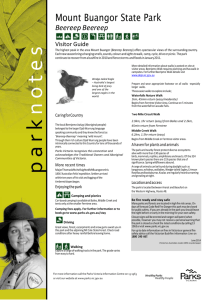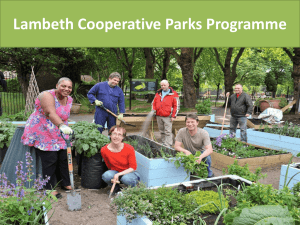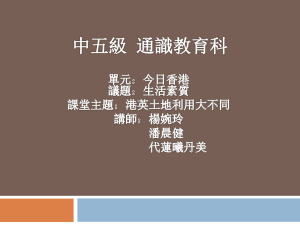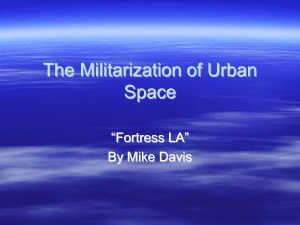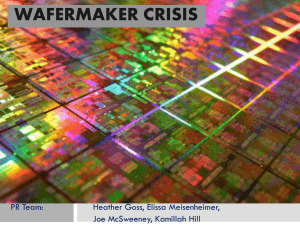Valuing Victoria`s Parks - Department of Environment, Land, Water
advertisement
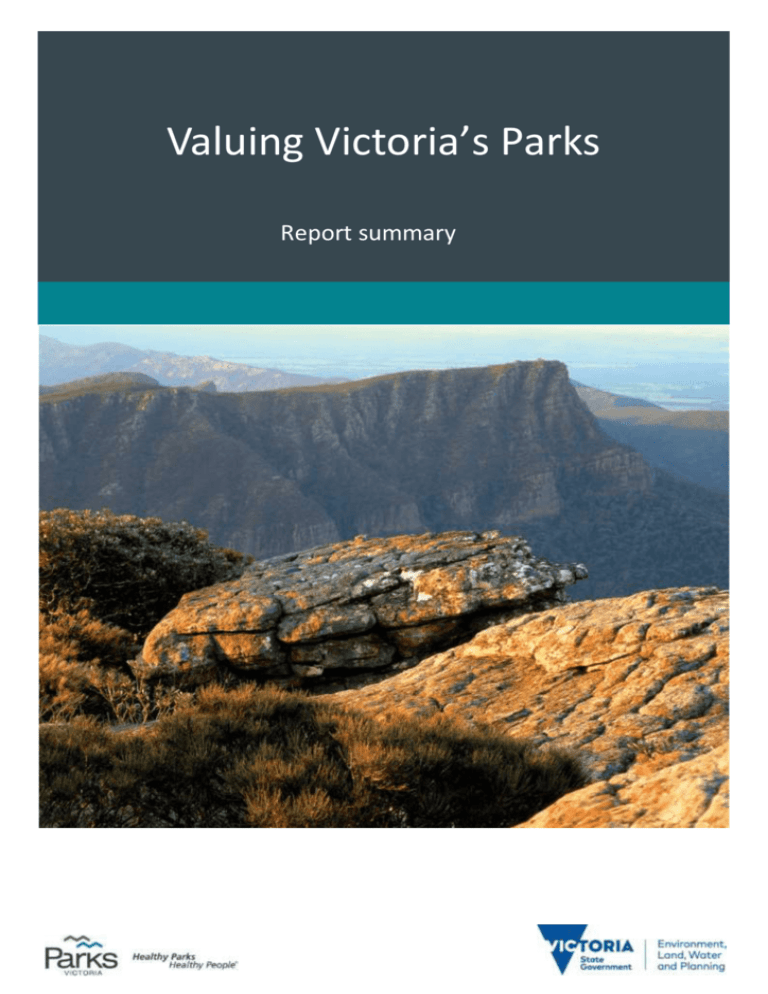
Valuing Victoria’s Parks Report summary © The State of Victoria Department of Environment, Land, Water and Planning 2015 This work is licensed under a Creative Commons Attribution 4.0 International licence. You are free to re-use the work under that licence, on the condition that you credit the State of Victoria as author. The licence does not apply to any images, photographs or branding, including the Victorian Coat of Arms, the Victorian Government logo and the Department of Environment, Land, Water and Planning (DELWP) logo. To view a copy of this licence, visit http://creativecommons.org/licenses/by/4.0/ Disclaimer This publication may be of assistance to you but the State of Victoria and its employees do not guarantee that the publication is without flaw of any kind or is wholly appropriate for your particular purposes and therefore disclaims all liability for any error, loss or other consequence which may arise from you relying on any information in this publication. Accessibility If you would like to receive this publication in an alternative format, please telephone DELWP Customer Service Centre 136 186, email customer.service@delwp.vic.gov.au (or relevant address), via the National Relay Service on 133 677 www.relayservice.com.au. This document is also available on the internet at www.delwp.vic.gov.au Valuing Victoria’s Parks A healthy environment is fundamental to Victoria’s economic and social wellbeing. The project Valuing Victoria’s Parks provides evidence of the economic and social benefits the parks network provides to Victorians. As part of ongoing work to support strategic management of parks, the Valuing Victoria’s Parks project was developed between Parks Victoria and the Department of Environment, Land, Water and Planning (DELWP). The project’s objective was to establish a framework that could quantify the benefits park ecosystems provide to the Victorian community. Victoria’s natural assets have unique intrinsic values and are the basis for many regional industries, such as agriculture and tourism. They contribute to the State’s liveability and sustainability by providing benefits such as clean water and air, and habitats for native species. Victoria’s parks are central to the conservation of environmental assets and biodiversity features. Parks also allow people to connect with nature and learn about our environment. Less recognised than these roles, however, is the critical role that parks play in maintaining liveability in our society and supporting our economy. This project uses a recently developed accounting framework, based on the international System of Environmental-Economic Accounting. The framework provides methods for reporting on environmental assets and assessing their contribution to society. This approach can help explain and reveal the benefits of environmental assets and demonstrate their importance, beyond their intrinsic values. In the context of parks, the approach to assess the contribution their ecosystems make to Victoria’s economic and social wellbeing consisted of three stages: Using an accounting framework for reporting on the stock and condition of Victoria’s environmental assets Quantification of the physical flows of goods and services from ecosystems that benefit the community (often referred to as ecosystem services) Valuation of the benefits that Victorians gain from the provision of ecosystem services from parks Key findings from each of these stages are outlined below. Environmental assets in the parks network The asset accounts provide an inventory of key parks assets and highlight their significance. The parks network covers 16% of Victoria and consists of 3.7 million hectares of protected areas and around 200,000 hectares of non-protected areas. The parks network contains: - 38% of all native vegetation in Victoria with an average condition 44% higher than vegetation outside the parks network - 42% of Victoria’s wetlands and 60% of Victoria’s wetlands of international significance - high quality habitat (greater than 60% suitability) for at least 770 significant conservation species Cultural assets of Aboriginal significance within the parks network include over 11,800 sites, from which: - 41% are artefact scatter sites - 29% are scarred trees - 16% are shell middens The parks network also has numerous historical places and contains significant built infrastructure with 28,000 built assets including 44 visitor centres, 703 shelters, 515 viewing lookouts and many others including playgrounds, sporting facilities and restrooms. Valuing Victoria’s Parks Report Summary 2 Flows of ecosystem services from parks The assessment of ecosystem services shows parks provide a wide range of benefits, such as: Provisioning goods Provisioning goods are the tangible resources or materials from ecosystems that provide benefits to people. They include: Clean water – over one million hectares of water catchments exist in the parks network. The catchment areas capture and clean rainfall, which is stored and distributed for drinking water and agricultural uses. Nine high water yielding parks supply 3,400 gigalitres (or 16% of the State total). Honey production – beehives located in parks are estimated to produce between 1,200 to 1,600 tonnes of honey products each year. Regulating services Regulating services are ecological processes that benefit people by affecting their environment. The services for which data are available include: Water purification – parks prevent sedimentation of streams and water supplies, and protecting parks lowers the amount of sediments by at least 45,000 tonnes per annum. Carbon storage – the parks network is a major carbon sink, with over 270 million tonnes of carbon stored across land and coastal habitats. Coastal protection – around 285 kilometres of coastal wetlands and dunes protect communities from storm surge events, sea inundation and coastal erosion. Pollination – the parks network hosts 1,200 to 1,700 honeybee sites, together with habitats for a range of insects, birds and bats that pollinate plants essential for fruit, vegetables and seeds for human use. Habitats for native species – assessment of 638 parks and reserves showed that they provide 888 rare and threatened species with at least 50% of the suitable habitat they need. Cultural services Cultural services are defined as non-material outputs of ecosystems that have cultural, symbolic or intellectual significance to people. They include: Recreation – parks provide opportunities for recreation with 51 million visits every year, and almost 17 million visitor nights from tourists annually. Landscape and neighbourhood amenity – parks provide amenity benefits to surrounding residents, estimated at 12,000 residences immediately adjacent to Melbourne parks and 85,000 residences adjacent to parks in regional Victoria. Indigenous cultural connection – there are almost 12,000 indigenous cultural places recorded in the parks network. Approximately 650,000 hectares are jointly or co-managed with Traditional Owners, which enable connection to country. Social & community cohesion – community members that volunteer in parks gain social connection, a sense of community contribution, and health benefits. They spent over 200,000 hours on park projects in 2013. Species/ecosystem existence – many people in Victoria value parks for altruistic reasons, as a bequest for future generations, and/or because they simply derive pleasure from knowing a species or ecosystem exists. Valuing Victoria’s Parks Report Summary 3 Valuation of benefits from parks Valuation is not about putting a price on nature, but about recognising its importance to the community. Monetary values of benefits can be useful in economic and policy analysis. The contribution of parks to Victorians’ wellbeing is expressed in terms of: (1) the economic activity currently supported by parks, and (2) the welfare benefits from protecting parks compared to an alternative land use. Economic activity supported by parks - Tourists spend $1.4 billion per year associated with their visits to parks, which generate $1 billion gross value added and 14,000 jobs to the State economy. - Honey and related products from hives in parks are worth $3.4-$4.6 million per year. - Pollination payments to beekeepers are estimated at $0.6-$1 million each year. Welfare benefits from parks - Water purification benefits are valued at $33 million per year in metropolitan areas and $50 million per year in non-metropolitan areas, from avoided costs. - Flood protection benefits are valued at $46 million per year from avoided infrastructure costs. - Coastal protection benefits are valued at $24-$56 million per year from avoided costs. - Pollination benefits to producers and consumers of agricultural products are $123-$167 million per year. - Recreational benefits are valued at $600-$1,000 million per year. Health benefits for physically active visitors are valued at $80-$200 million per year from avoided disease, mortality and lost productivity. - Amenity benefits to residents adjacent to parks in Melbourne are valued at $21-28 million per year. - Historical heritage benefits are valued at $6-$23 million per year. - Social cohesion benefits are valued at $6 million per year from volunteering in parks. The way forward The Victorian Government is committed to continuing work to value and account for Victoria’s environment to recognise the fundamental role of environmental assets in sustaining our communities. Environmental-economic accounting is a catalyst for better planning, providing a consistent framework for reporting on our ecosystem assets and the services these provide over time. The approach used in this project provides a better understanding of the contribution of environmental assets to the community and the economy. It will also provide consistent information to support public land planning and management. Over time, this work will be a foundation for more complete measures of State wealth and progress. If you would like to find out more about this project or work on accounting and valuation of environmental assets in Victoria, please contact: - Vivienne Claire (Vivenne.clare@delwp.vic.gov.au), Helen Betts O’Shea (helen.bettsoshea@delwp.vic.gov.au) Mark Eigenraam (mark.e.eigenraam@delwp.vic.gov.au) Tony Varcoe (tvarcoe@parks.vic.gov.au) Valuing Victoria’s Parks Report Summary 4



